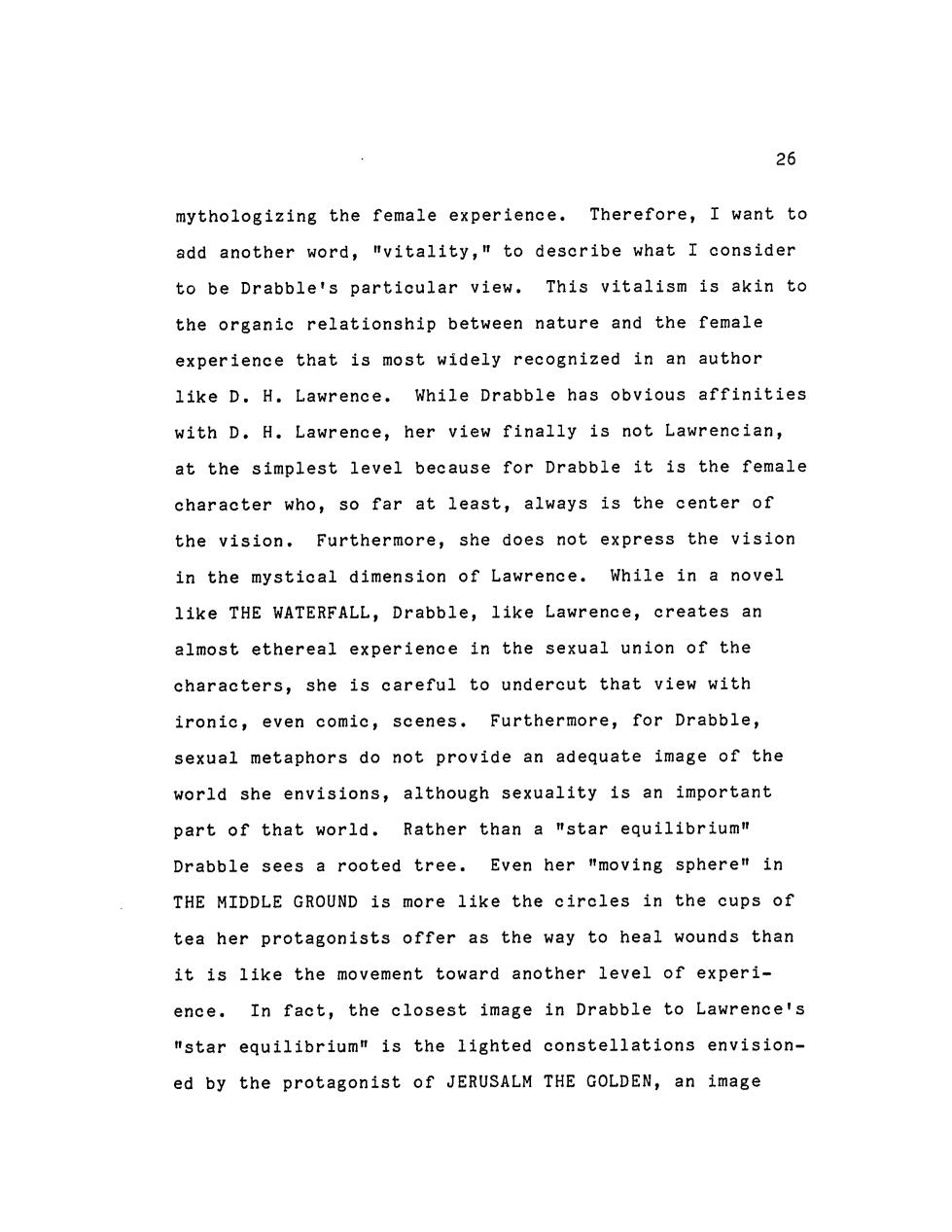
26 mythologizing the female experience.Therefore,I want to add another word,"vitality,"to describe what I consider to be Drabble's particular view.This vitalism is akin to the organic relationship between nature and the female experience that is most widely recognized in an author like D.H.Lawrence.While Drabble has obvious affinities with D.H.Lawrence,her view finally is not Lawrencian, at the simplest level because for Drabble it is the female character who,so far at least,always is the center of the vision.Furthermore,she does not express the vision in the mystical dimension of Lawrence.While in a novel like THE WATERFALL,Drabble,like Lawrence,creates an almost ethereal experience in the sexual union of the characters,she is careful to undercut that view with ironic,even comic,scenes.Furthermore,for Drabble, sexual metaphors do not provide an adequate image of the world she envisions,although sexuality is an important part of that world.Rather than a "star equilibrium" Drabble sees a rooted tree.Even her "moving sphere"in THE MIDDLE GROUND is more like the cireles in the cups of tea her protagonists offer as the way to heal wounds than it is like the movement toward another level of experi- ence.In fact,the closest image in Drabble to Lawrence's "star equilibrium"is the lighted constellations envision- ed by the protagonist of JERUSALM THE GOLDEN,an image
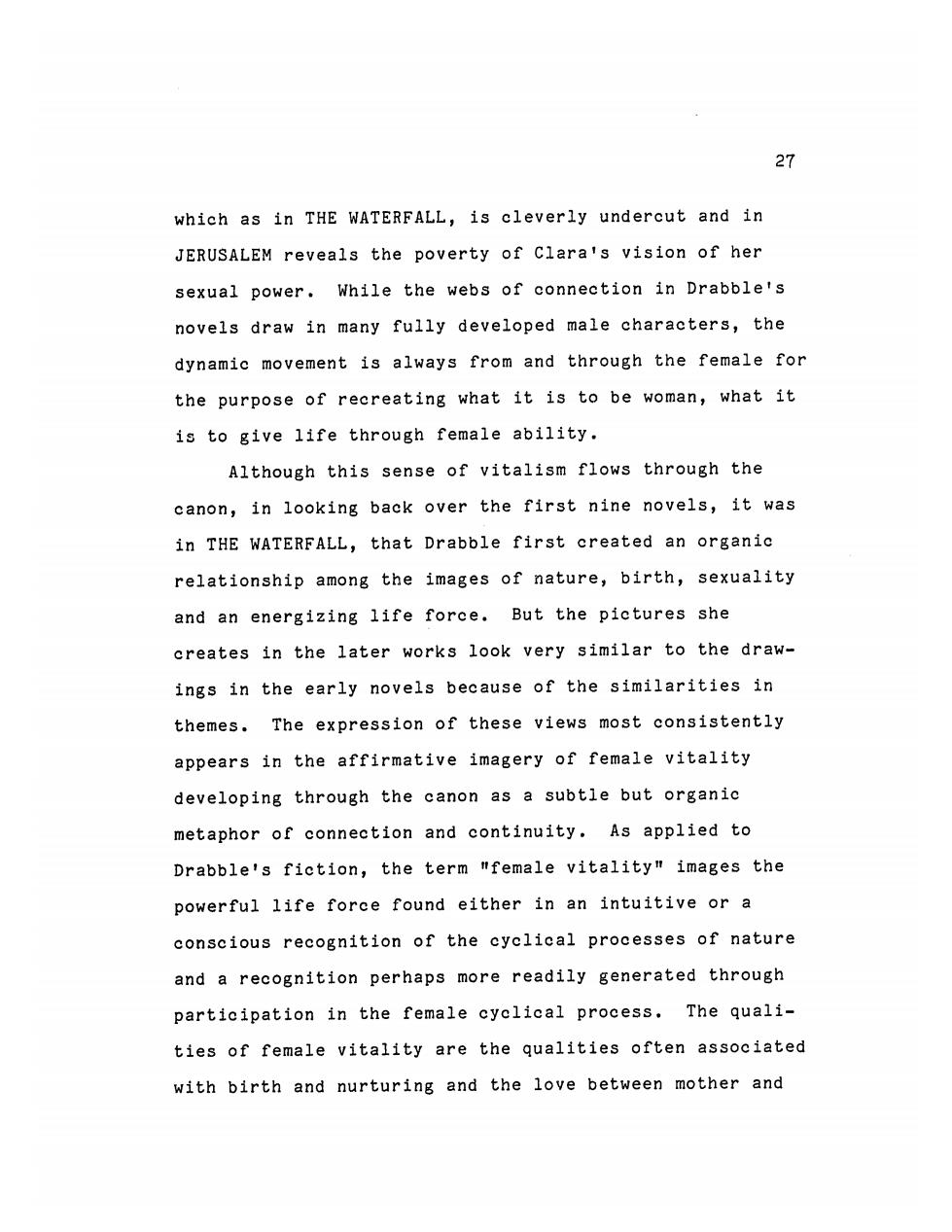
27 which as in THE WATERFALL,is cleverly undercut and in JERUSALEM reveals the poverty of clara's vision of her sexual power.While the webs of connection in Drabble's novels draw in many fully developed male characters,the dynamic movement is always from and through the female for the purpose of recreating what it is to be woman,what it is to give life through female ability. Although this sense of vitalism flows through the canon,in looking back over the first nine novels,it was in THE WATERFALL,that Drabble first created an organic relationship among the images of nature,birth,sexuality and an energizing life force.But the pictures she creates in the later works look very similar to the draw- ings in the early novels because of the similarities in themes.The expression of these views most consistently appears in the affirmative imagery of female vitality developing through the canon as a subtle but organic metaphor of connection and continuity.As applied to Drabble's fiction,the term "female vitality"images the powerful life force found either in an intuitive or a conscious recognition of the cyclical processes of nature and a recognition perhaps more readily generated through participation in the female cyclical process.The quali- ties of female vitality are the qualities often associated with birth and nurturing and the love between mother and
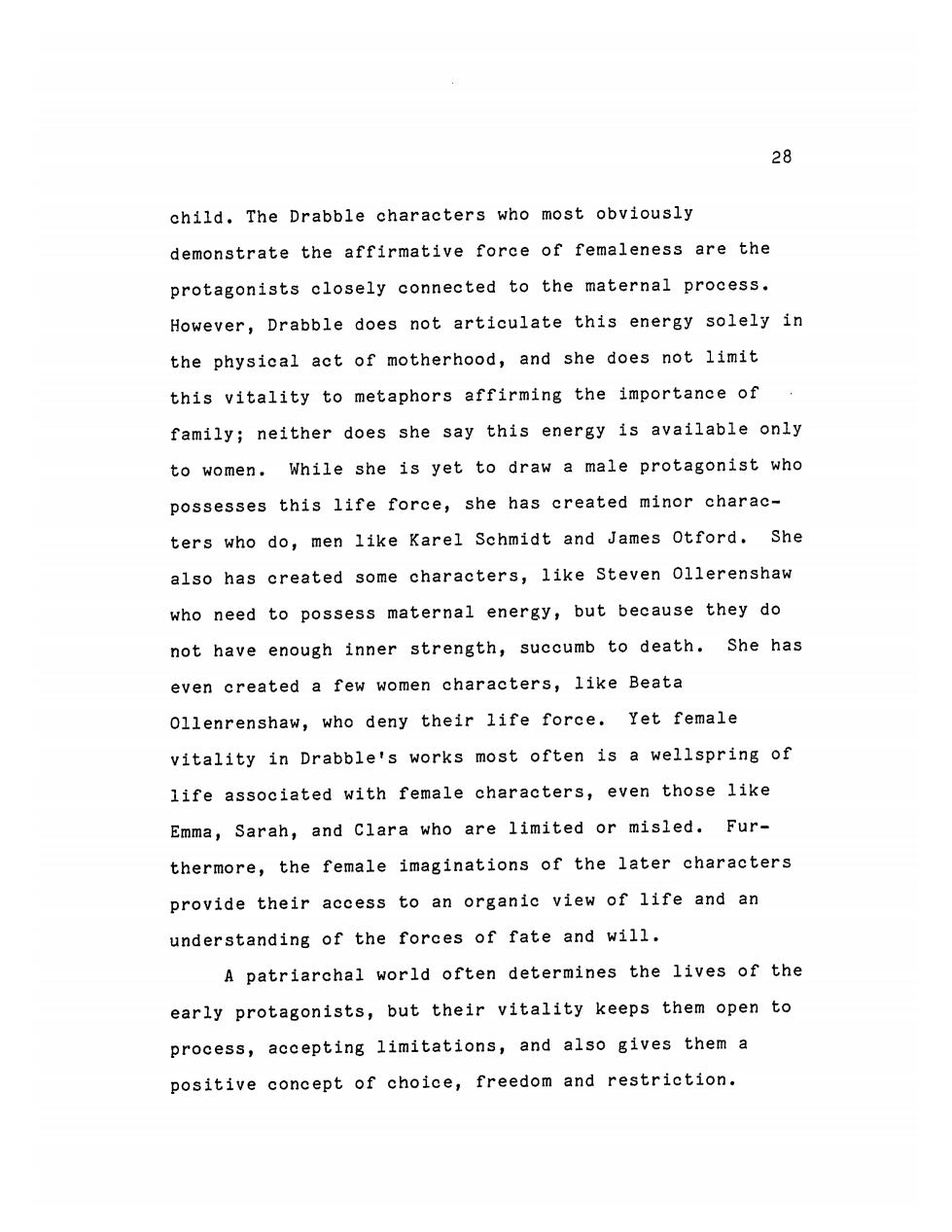
28 child.The Drabble characters who most obviously demonstrate the affirmative force of femaleness are the protagonists closely connected to the maternal process. However,Drabble does not articulate this energy solely in the physical act of motherhood,and she does not limit this vitality to metaphors affirming the importance of family;neither does she say this energy is available only to women.While she is yet to draw a male protagonist who possesses this life force,she has created minor charac- ters who do,men like Karel Schmidt and James Otford.She also has created some characters,like Steven 0llerenshaw who need to possess maternal energy,but because they do not have enough inner strength,succumb to death.She has even created a few women characters,like Beata 0llenrenshaw,who deny their life force.Yet female vitality in Drabble's works most often is a wellspring of life associated with female characters,even those like Emma,Sarah,and clara who are limited or misled.Fur- thermore,the female imaginations of the later characters provide their access to an organic view of life and an understanding of the forces of fate and will. A patriarchal world often determines the lives of the early protagonists,but their vitality keeps them open to process,accepting limitations,and also gives them a positive concept of choice,freedom and restriction
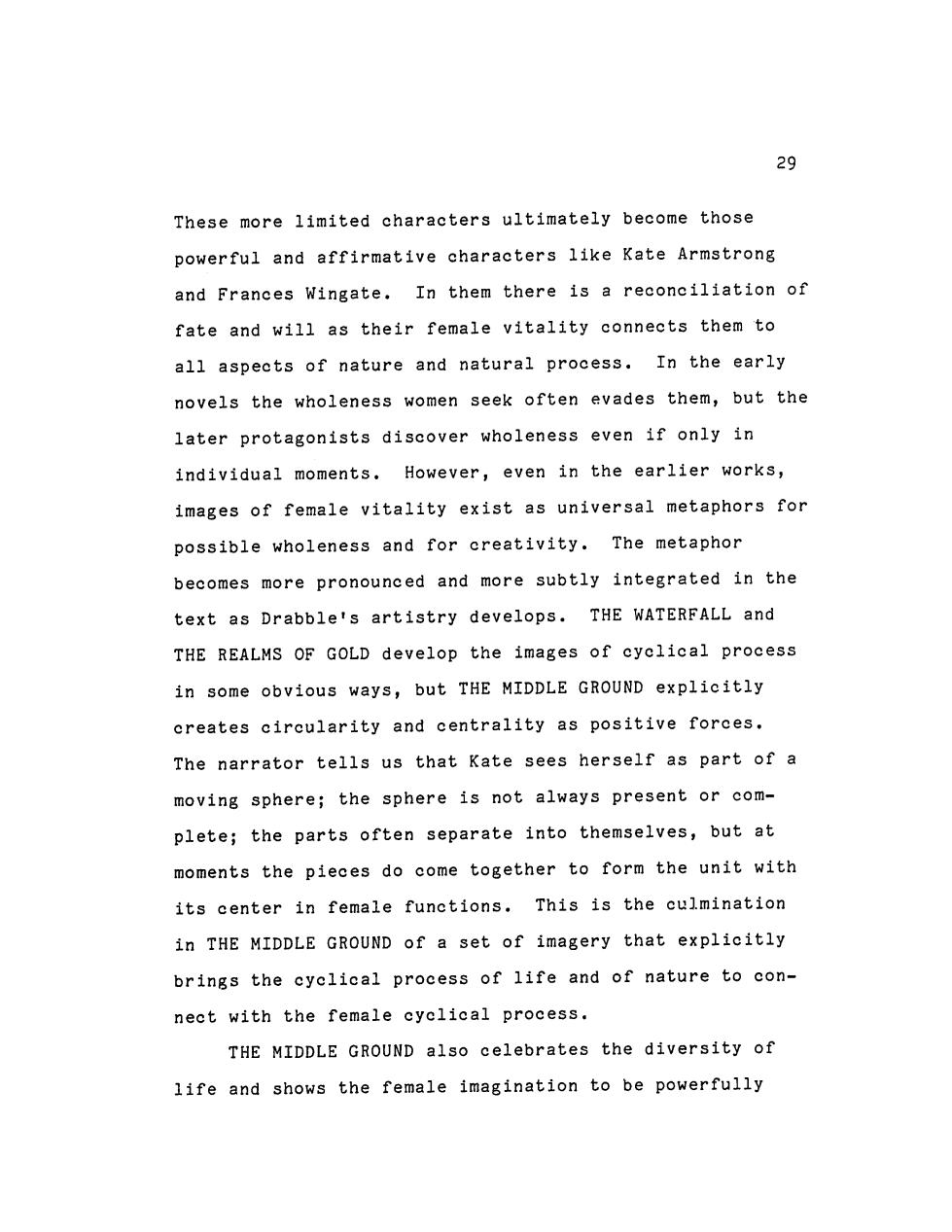
29 These more limited characters ultimately become those powerful and affirmative characters like Kate Armstrong and Frances Wingate.In them there is a reconciliation of fate and will as their female vitality connects them to all aspects of nature and natural process.In the early novels the wholeness women seek often evades them,but the later protagonists discover wholeness even if only in individual moments.However,even in the earlier works, images of female vitality exist as universal metaphors for possible wholeness and for creativity.The metaphor becomes more pronounced and more subtly integrated in the text as Drabble's artistry develops.THE WATERFALL and THE REALMS OF GOLD develop the images of cyelical process in some obvious ways,but THE MIDDLE GROUND explicitly creates circularity and centrality as positive forces. The narrator tells us that Kate sees herself as part of a moving sphere;the sphere is not always present or com- plete;the parts often separate into themselves,but at moments the pieces do come together to form the unit with its center in female functions.This is the culmination in THE MIDDLE GROUND of a set of imagery that explicitly brings the cyclical process of life and of nature to con- nect with the female cyclical process. THE MIDDLE GROUND also celebrates the diversity of life and shows the female imagination to be powerfully
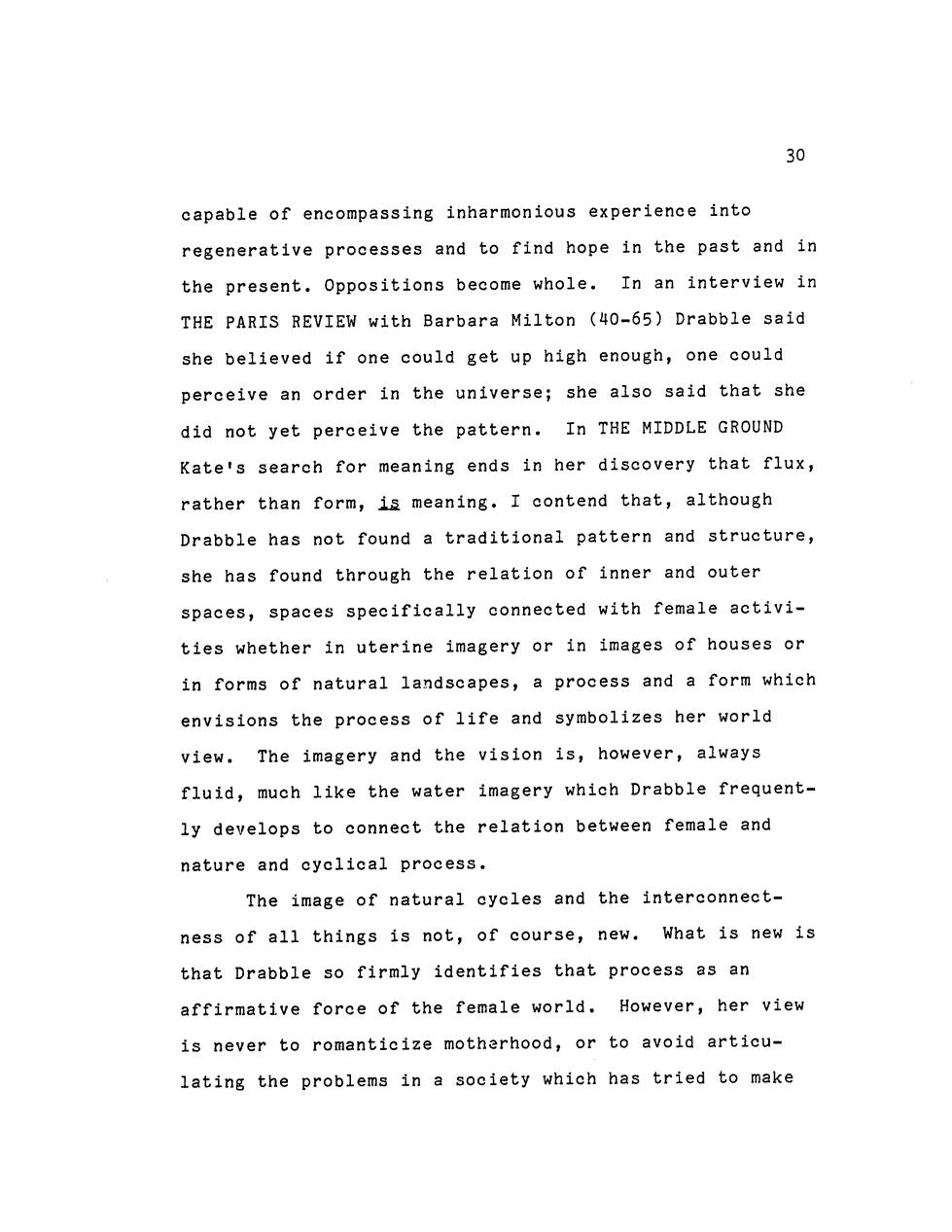
30 capable of encompassing inharmonious experience into regenerative processes and to find hope in the past and in the present.Oppositions become whole.In an interview in THE PARIS REVIEW with Barbara Milton (40-65)Drabble said she believed if one could get up high enough,one could perceive an order in the universe;she also said that she did not yet perceive the pattern.In THE MIDDLE GROUND Kate's search for meaning ends in her discovery that flux, rather than form,is meaning.I contend that,although Drabble has not found a traditional pattern and structure, she has found through the relation of inner and outer spaces,spaces specifically connected with female activi- ties whether in uterine imagery or in images of houses or in forms of natural landscapes,a process and a form which envisions the process of life and symbolizes her world view.The imagery and the vision is,however,always fluid,much like the water imagery which Drabble frequent- ly develops to connect the relation between female and nature and cyclical process. The image of natural cycles and the interconnect- ness of all things is not,of course,new.What is new is that Drabble so firmly identifies that process as an affirmative force of the female world.However,her view is never to romanticize motherhood,or to avoid articu- lating the problems in a society which has tried to make